Sisowath Kossamak
Sisowath Kossamak (Khmer: ស៊ីសុវត្ថិ កុសមៈ; 9 April 1904 – 27 April 1975) was the Queen consort of Cambodia by marriage to King Norodom Suramarit from 1955 to his death in 1960. After her husband's death, she became the Queen of Cambodia, largely for ceremonial purposes, while her son Norodom Sihanouk was effectively the chief of state. Sisowath Kossamak was born Princess of Cambodia as the daughter of King Sisowath Monivong and his wife Norodom Kanviman Norleak Tevi. Her official title was Preah Mohasatreiyani Sisowath Monivong Kossamak Nearirath Serey Vathana (Khmer: ព្រះមហាក្សត្រិយានី ស៊ីសុវត្ថិមុនីវង្ស កុសុមៈនារីរ័ត្នសេរីវឌ្ឍនា). She is one of only three female monarchs in Cambodian history, the others being Queen Soma, and Queen Ang Mey.
| Sisowath Kossamak | |||||
|---|---|---|---|---|---|
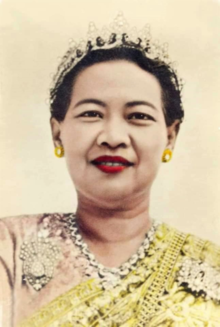 | |||||
| Queen of Cambodia | |||||
| Reign | 20 June 1960 – 9 October 1970 | ||||
| Predecessor | Norodom Suramarit | ||||
| Successor | Monarchy abolished Cheng Heng (as President of the Khmer Republic) | ||||
| Regent | Norodom Sihanouk Cheng Heng | ||||
| Queen consort of Cambodia | |||||
| Tenure | 2 March 1955 – 3 April 1960 | ||||
| Coronation | 6 March 1956 | ||||
| Born | 9 April 1904 Phnom Penh, Cambodia, French Indochina | ||||
| Died | 27 April 1975 (aged 71) Beijing, People's Republic of China | ||||
| Spouse | |||||
| Issue | Norodom Sihanouk | ||||
| |||||
| House | House of Sisowath (by birth) House of Norodom (by marriage) | ||||
| Father | Sisowath Monivong | ||||
| Mother | Norodom Kanviman Norleak Tevi | ||||
| Religion | Theravada Buddhism | ||||
Upon the death of Monivong in 1941, Sihanouk took the throne. In 1955, he abdicated in favor of his father Suramarit, who then reigned for five years. After her husband's death, Kossamak became the symbol and representative of the monarchy while Sihanouk assumed a role equal to that of a monarch. After the coup of 1970, she was placed under arrest, but retained her title before being stripped of all status during the formal proclamation of the republic in October 1970. She remained under house arrest until her health declined in 1973, and she was allowed to join her son in China.[1] Kossamak died in Beijing on 27 April 1975, ten days after the Khmer Rouge captured Phnom Penh.
Biography

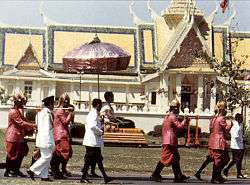
Sisowath Kosamak married her father's cousin Norodom Suramarit in 1920. Upon the death of her father Monivong in 1941, Sihanouk, her son and Monivong's grandson, was selected as the new king. In the 1940s, she famously choreographed the apsara dance by training her first grand daughter, Princess Norodom Bopha Devi, to become the first Apsara dancer.
In 1955, Sihanouk abdicated in favour of his father. Queen Kossamak enjoyed great respect and popularity: despite neither a monarch nor politically influential, she was said to exert great moral authority over the khmers, was described as generous to the poor and devoting herself to the welfare of the nation.[2] As queen, she received foreign guests and hosted state functions, were the Royal ballet of Cambodia often performed.[2] Like her daughter-in-law, she was accused of promoting proteges to civil offices.[2] She was not on good terms with her daughter-in-law, Princess Monique, which led to advisories blaming Monique for the sometime strained relationship between Kossamak and Sihanouk, and for Sihanouk alleged initial hesitance to abdicate as it would make his mother queen.[2]
Following Suramarit's death in 1960, Norodom Sihanouk again became head of state (although he did not formally regain the title of king until 1993). There were suggestions of changing the constitution to allow for Kossamak to succeed as queen regnant and monarch in her own name, but the royal council was unwilling to allow it: her son Sihanouk stated that only God knew his reasons to why he did not wish his mother to succeed to the throne.[2]
Queen Kossamak continued in her representational role during the reign of her son as premier during the 1960s.[2] She also upheld her great popularity. In 1965, a serious conflict arouse, when an American paper published slander accusing her of greed and of managing brothels. This incident led to the attack of the American embassy in Phnom Penh and Sihanouk cutting diplomatic relations with the USA.
After the Cambodian coup of 1970, Kossamak was forced to leave the royal palace by the new government and held in house arrest in a villa in the suburb. She was allowed to join her son in Beijing in China for health reasons in 1973. She died in China two years later.
Honours
Foreign honours


_-_DMN.svg.png)


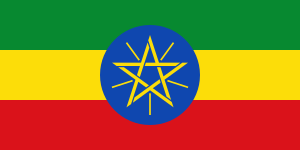



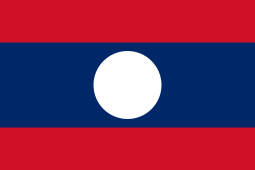
.png)
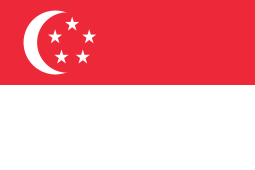

.svg.png)


References
- "Cambodian Queen is dead in Peking". The New York Times. 28 April 1975. Retrieved 5 June 2020.
- Jacobsen, Trudy (2008). Lost Goddesses: The Denial of Female Power in Cambodian History. NIAS Press. ISBN 978-87-7694-001-0.
- "Senarai Penuh Penerima Darjah Kebesaran, Bintang dan Pingat Persekutuan Tahun 1964" (PDF).
- "Cambodian Apsara Dance". Web of Cambodia.
- "Cambodia Heads of State". Worldwide Guide to Women in Leadership. 2009-07-12.
Sisowath Kossamak Born: 1904 Died: 27 April 1975 | ||
| Preceded by Norodom Monineath |
Queen consort of Cambodia 3 March 1955 – 3 April 1960 |
Succeeded by Norodom Monineath |